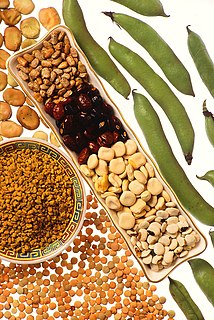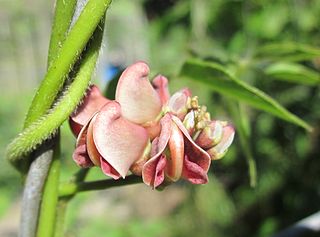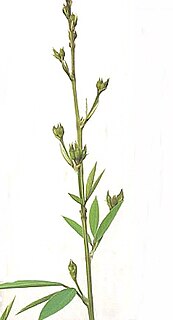
A bean is a seed of one of several genera of the flowering plant family Fabaceae, which are used for human or animal food.

The peanut, also known as the groundnut, goober, or monkey nut (UK), and taxonomically classified as Arachis hypogaea, is a legume crop grown mainly for its edible seeds. It is widely grown in the tropics and subtropics, being important to both small and large commercial producers. It is classified as both a grain legume and, due to its high oil content, an oil crop. World annual production of shelled peanuts was 44 million tonnes in 2016, led by China with 38% of the world total. Atypically among legume crop plants, peanut pods develop underground (geocarpy) rather than aboveground. With this characteristic in mind, the botanist Linnaeus named the species hypogaea, which means "under the earth."

The Fabaceae or Leguminosae, commonly known as the legume, pea, or bean family, are a large and economically important family of flowering plants. It includes trees, shrubs, and perennial or annual herbaceous plants, which are easily recognized by their fruit (legume) and their compound, stipulate leaves. Many legumes have characteristic flowers and fruits. The family is widely distributed, and is the third-largest land plant family in terms of number of species, behind only the Orchidaceae and Asteraceae, with about 751 genera and about 19,000 known species. The five largest of the genera are Astragalus, Acacia, Indigofera, Crotalaria, and Mimosa, which constitute about a quarter of all legume species. The ca. 19,000 known legume species amount to about 7% of flowering plant species. Fabaceae is the most common family found in tropical rainforests and in dry forests in the Americas and Africa.

Arachis is a genus of about 70 species of annual and perennial flowering plants in the pea family (Fabaceae), native to South America, and was recently assigned to the informal monophyletic Pterocarpus clade of the Dalbergieae. At least one species, the peanut, is a major food crop species of global importance; some of the other species are cultivated for food to a small extent in South America. Other species such as A. pintoi are cultivated worldwide as forage and soil conditioner plants, with the leaves providing high-protein feed for grazing livestock and a nitrogen source in agroforestry and permaculture systems.

Domestication is a sustained multi-generational relationship in which one group of organisms assumes a significant degree of influence over the reproduction and care of another group to secure a more predictable supply of resources from that second group.

A legume is a plant in the family Fabaceae, or the fruit or seed of such a plant. Legumes are grown agriculturally, primarily for human consumption, for livestock forage and silage, and as soil-enhancing green manure. Well-known legumes include alfalfa, clover, peas, chickpeas, lentils, lupin bean, mesquite, carob, soybeans, peanuts and tamarind. Legumes produce a botanically unique type of fruit – a simple dry fruit that develops from a simple carpel and usually dehisces on two sides. A common name for this type of fruit is a pod, although the term "pod" is also applied to a number of other fruit types, such as that of vanilla and of the radish.

Vigna subterranea is a member of the family Fabaceae. The plant originated in West Africa. Vigna subterranea ripens its pods underground, much like the peanut. They can be eaten fresh or boiled after drying.

The winged bean, also known as the Goa bean, four-angled bean, four-cornered bean, Manila bean, and dragon bean, is a tropical legume plant native to New Guinea.

Lablab purpureus is a species of bean in the family Fabaceae. It is native to Africa and it is cultivated throughout the tropics for food. English language common names include hyacinth bean, lablab-beanbonavist bean/pea, dolichos bean, seim bean, lablab bean, Egyptian kidney bean, Indian bean, bataw and Australian pea. It is the only species in the monotypic genus Lablab.

Vigna umbellata (Thunb.) Ohwi and Ohashi, previously Phaseolus calcaratus, is a warm-season annual vine legume with yellow flowers and small edible beans. It is commonly called ricebean or rice bean. To date, it is little known, little researched and little exploited. It is regarded as a minor food and fodder crop and is often grown as intercrop or mixed crop with maize, sorghum or cowpea, as well as a sole crop in the uplands, on a very limited area. Like the other Asiatic Vigna species, ricebean is a fairly short-lived warm-season annual. Grown mainly as a dried pulse, it is also important as a fodder, a green manure and a vegetable. Ricebean is most widely grown as an intercrop, particularly of maize, throughout Indo-China and extending into southern China, India, Nepal and Bangladesh. In the past it was widely grown as lowland crop on residual soil water after the harvest of long-season rice, but it has been displaced to a great extent where shorter duration rice varieties are grown. Ricebean grows well on a range of soils. It establishes rapidly and has the potential to produce large amounts of nutritious animal fodder and high quality grain.

Apios americana, sometimes called the potato bean, hopniss, Indian potato, hodoimo, America-hodoimo, American groundnut,or groundnut is a perennial vine that bears edible beans and large edible tubers. Its vine can grow to 1–6 m (3.3–19.7 ft) long, with pinnate leaves 8–15 cm (3.1–5.9 in) long with 5–7 leaflets. The flowers are usually pink, purple, or red-brown, and are produced in dense racemes 7.5–13 cm (3.0–5.1 in) in length. The fruit is a legume (pod) 5–13 cm (2.0–5.1 in) long. Botanically speaking, the tubers are rhizomatous stems, not roots. Its natural range is from Southern Canada down through Florida and West as far as the border of Colorado.
Arachis villosulicarpa is a perennial peanut species, which is cultivated by indigenous people in Mato Grosso, a state of Brazil. Its wild progenitor is thought to be Arachis pietrarellii. Although it is related to the common peanut, Arachis hypogaea, it was separately domesticated: A. villosulicarpa is diploid, whereas A. hypogaea is tetraploid.
The Collaborative Crop Research Program (CCRP) funds participatory, collaborative research on agroecological intensification (AEI). Funded projects typically link international, national, and local organizations with communities of smallholder farmers, researchers, development professionals, and other parties. Projects work together as part of a Community of Practice to generate technical and social innovations to improve nutrition, livelihoods, and productivity for farming communities in Africa and South America. Large-scale impact is realized when new ideas, technologies, or processes are adapted, when insights from research catalyze change in policy and practice, and when innovation inspires further success. The program is under the direction of Rebecca J. Nelson of Cornell University and Jane Maland Cady of the McKnight Foundation.
Antonio Krapovickas was an Argentine agronomist.

A crop wild relative (CWR) is a wild plant closely related to a domesticated plant, whose geographic origins can be traced to regions known as Vavilov Centers. It may be a wild ancestor of the domesticated plant, or another closely related taxon.

A grain is a small, hard, dry seed, with or without an attached hull or fruit layer, harvested for human or animal consumption. A grain crop is a grain-producing plant. The two main types of commercial grain crops are cereals and legumes.
The Legume Information System (LIS), is legume sciences portal specifically for legume breeders and researchers, established and supported by the Agricultural Research Service of the United States Department of Agriculture. The mission of the Legume Information System is "to facilitate discoveries and crop improvement in the legumes," in particular to improve crop yields, their nutritional value, and our understanding of basic legume science.

Rajeev Kumar Varshney is a geneticist or genomicist with more than 20 years of research experience in the area of international agriculture. He is currently working as global Research Program Director–Genetic Gains that includes several units viz. Genebank, Pre-Breeding, Cell, Molecular Biology & Genetic Engineering, Genomics & Trait Discovery, Forward Breeding, Seed Systems and Biotechnology- ESA at the International Crops Research Institute for the Semi-Arid Tropics (ICRISAT), Patancheru, India. He is Founding Director for the Center of Excellence in Genomics at ICRISAT and a Winthrop Research Professor with The University of Western Australia.
There are many systems of classification of crops for example commercial, taxonomical and agricultural among the agriculture classification of corrupt crops is most widely accepted because it is commonly it covers the taxonomical and commercial and other aspects.

The pigeon pea is a perennial legume from the family Fabaceae. Since its domestication in the Indian subcontinent at least 3,500 years ago, its seeds have become a common food in Asia, Africa, and Latin America. It is consumed on a large scale mainly in South Asia and is a major source of protein for the population of the Indian subcontinent.


















